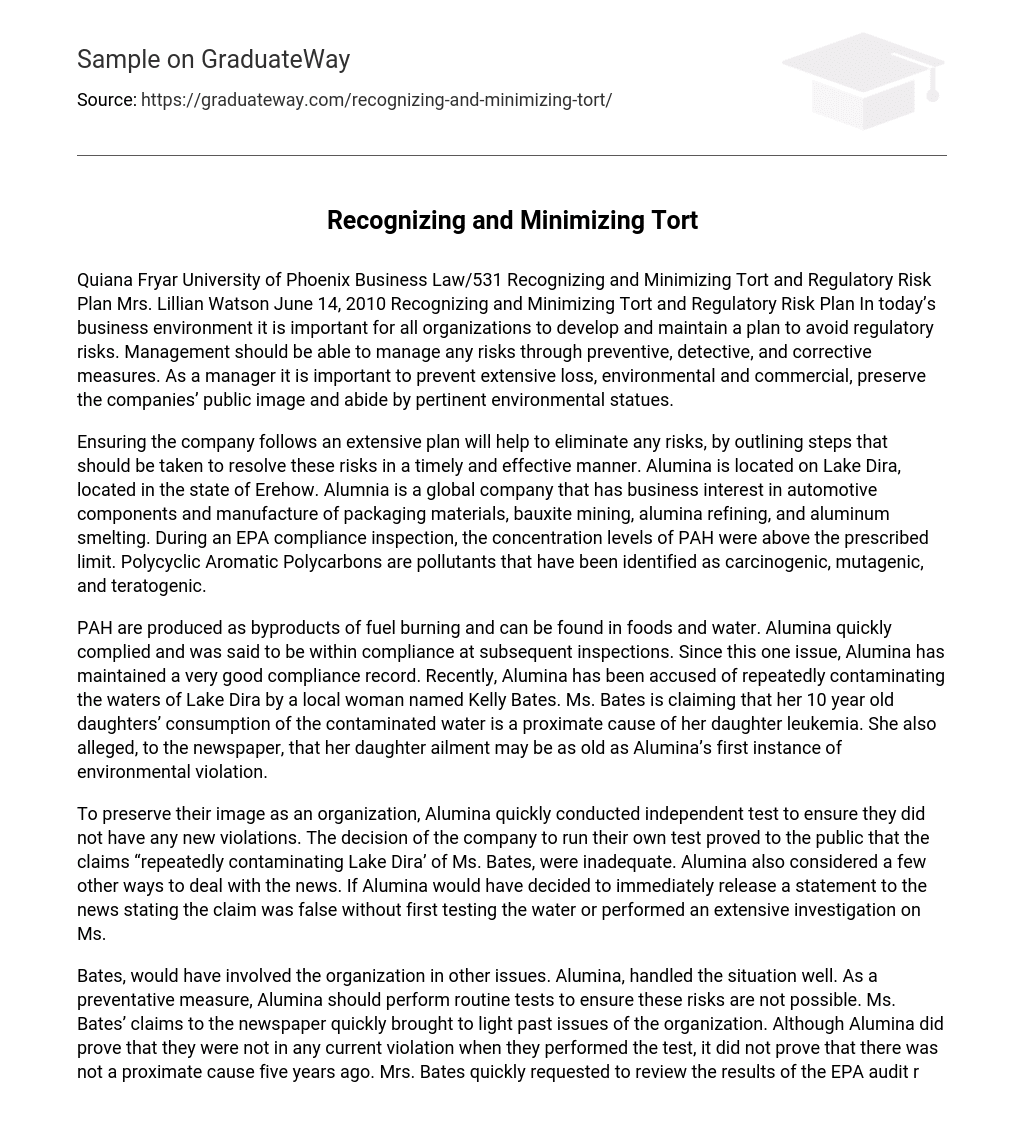In the current business landscape, it is crucial for every organization to establish and uphold a strategy to evade regulatory risks. Effective management should possess the ability to handle risks by employing preventive, detective, and corrective actions. For managers, preventing significant losses, whether environmental or commercial in nature, upholding the company’s public perception, and adhering to relevant environmental laws are of utmost importance.
Implementing a comprehensive plan allows the company to efficiently and quickly address risks, ensuring regulatory compliance. Alumina operates globally in industries such as automotive components, packaging materials manufacturing, bauxite mining, alumina refining, and aluminum smelting. In Erehow’s state on Lake Dira, during an EPA compliance inspection, Alumina encountered concentration levels of PAH that exceeded the prescribed limit. These pollutants are referred to as Polycyclic Aromatic Polycarbons (PAHs) and have been categorized as carcinogenic, mutagenic, and teratogenic.
PAHs are substances that are generated when fuel is burned and can exist in both food and water. Despite one occurrence, Alumina has consistently adhered to compliance standards during inspections and has a strong record of abiding by regulations. However, Alumina is presently facing allegations from Kelly Bates, a local resident, who accuses the company of recurrently polluting Lake Dira’s waters. As per Ms. Bates, her 10-year-old daughter developed leukemia after consuming the contaminated water. She also suggested that her daughter’s illness may have originated from the time when Alumina initially violated environmental rules.
To protect their reputation, Alumina promptly carried out an independent test to confirm the absence of any new violations. By conducting their own test, the company demonstrated to the public that Ms. Bates’ claims of “repeatedly contaminating Lake Dira” were insufficient. Alumina also explored alternative approaches to address the situation. Instead of releasing a statement declaring the claim as false without verifying the water quality or conducting a thorough investigation on Ms. Bates, Alumina opted to conduct their own test.
Bates, would have engaged the organization in additional matters. Alumina effectively managed the situation. As a precautionary step, Alumina should conduct regular tests to verify the absence of these risks. Ms. Bates’ statements to the newspaper promptly exposed previous problems within the organization. Although Alumina did demonstrate compliance at the time of the test, it did not establish the absence of a direct cause five years ago. Mrs. Bates promptly requested access to the findings of the EPA audit reports.
The public has the right to review governmental documents under exemption 4 of the Freedom of Information Act. The absence of an appeal from Alumina suggests that their mistake was unintentional and they have no hidden motives. Moreover, Alumina’s ability to continue competing in its market trade remains unaffected. However, the incident that occurred five years ago showcased negligence on Alumina’s part as it failed to implement safety measures, potentially resulting in violations of both the Clean Water Act and the Safe Drinking Act. These acts were enacted to ensure the safety of the environment, public, and company.
Even though the acts were proven to have occurred five years ago, Ms. Bates still had a valid claim. At one stage, the organization aimed to violate Ms. Bates’ privacy and investigate her in order to discover additional reasons to accuse Alumina. The company should never seek this violation as they have neglected their responsibility to properly dispose of waste products. Alumina is obligated to exercise care for the well-being of the public. If they had conducted an investigation and publicly used it, violating Ms. Bates could have also exposed the company to liability for libel and defamation of character.
Bates and the newspaper had the potential to harm the company’s reputation publicly, which could have been deemed libelous. It is crucial that all information presented holds true and reflects ethical principles. Alumina’s wise choice to resolve the dispute through alternative dispute resolution enabled both parties to address the matters at hand privately, without the interference of the public or media. Mediation was agreed upon by both parties as the method to reach a resolution.
The mediator, who has no direct affiliation with either party, can assist in reaching a mutually beneficial resolution, enabling Alumina to protect their reputation and avoid expensive legal actions. Ms. Bates received punitive damages and agreed to a strict confidentiality agreement. All accusations were dismissed, and no specifics were revealed. All organizations must comply with local, state, and government regulations. Neglecting any laws may result in consequences from both authorities and the general public.
In order to attract business, having a strong public image is vital. The initial step involves identifying and preventing risks associated with the organization. If any risks have already occurred, understanding how to rectify them is crucial. Alumina can reduce risks to the public and environment by conducting regular tests that adhere to EPA guidelines.





